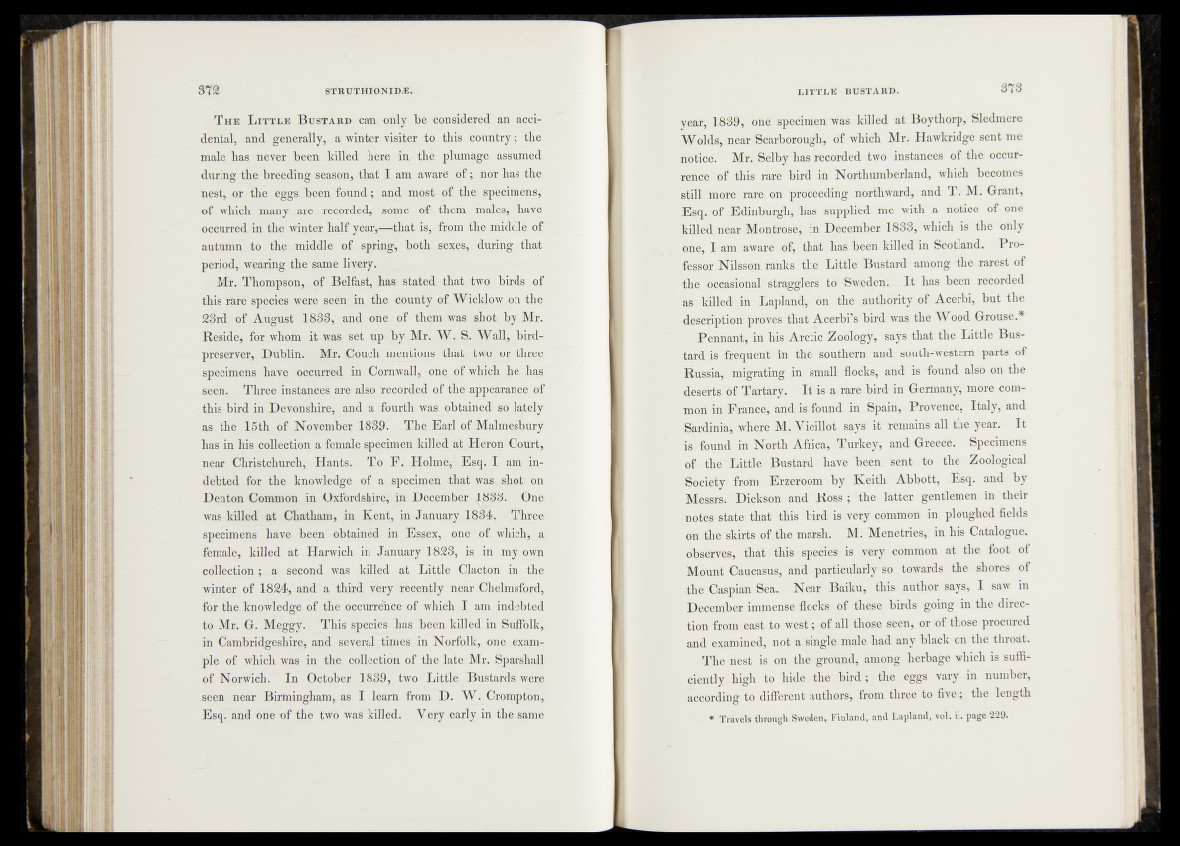
T he L ittle Bustard can only be considered an accidental,
and generally, a winter visiter io. this country ; the
male has never been killed here in the plumage assumed
during the breeding season, that I am aware of ; nor has the
nest, or the eggs been found ; and most of the specimens,
of which many are recorded, some of them males,, have
occurred in the winter half year,—that is, from the-middle of
autumn to the middle of spring, both sexes, during that
period, wearing the same livery.
Mr. Thompson, of Belfast, has stated that two birds of
this rare species were seen in the county of Wicklow on tjie
28rd of August 1888, and one of them was shot by Mr.
Reside, for whom it was set up by Mr. W. S.. Wall, bijd-
preserver, Dublin. Mr. Couch mentions that two orVthree
specimens have occurred in Cornwall, one of which he has
seen. Three instances are also recorded of the appearance of
this bird in Devonshire, and a fourth was -obtained so lately
as the 15th of November 1889. The Earl of Malm-esbury-
has in his collection a female specimen killed at Héron Court,
near Christchurch, Hants. To F . Holme, Esq. I am indebted
for the-knowledge of a specimen that was shot; on
Denton Common in Oxfordshire, in December 1888. One
was killed at Chatham, in Kent, in January 1881. Three
specimens have been obtained in Essex, one. of. which-,, a
female, killed at Harwich in January 1828, is in my own
collection ; a second was killed at Little Clacton in the
winter of 1824, and a third very recently near Chelmsford,
for the knowledge of the occurrence of which I am indebted
to Mr. G. Meggy. This species has been killed in Suffolk,
in Cambridgeshire, and several times in Norfolk, one example
of which was in the collection, of the late Mr. Sparshall
of Norwich. In October 1889, two Little Bustards were
seen near Birmingham, as I learn from D. W- Crompton,
Esq. and one of the two was killed. Very early in the same
year, 1889, one specimen was killed at Boy thorp, Sledmere
Wolds, near Scarborough, of which Mr. Hawkridge sent me
notice. Mr. Selby has recorded two instances of the occurrence
of this rare bird in Northumberland, which becomes
still more rare on proceeding northward, and T. M. Grant,
Esq. of Edinburgh, has supplied me with a notice of one
killed near Montrose, in December 1883, which is the only
one, I am aware of, that has been killed in Scotland. Professor
Nilsson ranks the Little Bustard among the rarest of
the occasional stragglers to Sweden. I t has been recorded
as killed in Lapland, on the authority of Acerbi, but the
description proves that Acerbi’s bird was the Wood Grouse.*
Pennant, in his Arctic Zoology, says that the Little Bustard
is frequent in the southern and south-western parts of
Russia, migrating- in small flocks, and is found also on the
deserts of Tartary, I t is a rare bird in Germany, more common
in France^ and is found in Spain, Provence, Italy, and
Sardinia, where M. Yieillot says it remains all the year. I t
is found in North Africa, Turkey, and Greece. Specimens
of thCLnttle Bustard have been sent to the Zoological
Society from Erzeroom by Keith Abbott, Esq. and by
Messrs. Dickson and Ross ; the latter gentlemen in their
notes, state that this bird is very common in ploughed fields
on the skirts of the marsh. M. Menetries, in his Catalogue,
observes, that this species is very common at the foot of
Mount Caucasus, and particularly so towards the shores of
the Caspian Sea. Near Baiku, this author says, I saw in
December immense flocks of these birds going in the direction
from east to west; of all those seen, or of those procured
and examined, not a single male had any black on the throat.
The nest is on the ground, among herbage which is sufficiently
high to hide the bird ; the eggs vary in number,
according to different authors, from three to five; the length
* Travels through Sweden, Finland, and Lapland, vol. ii. page 229.